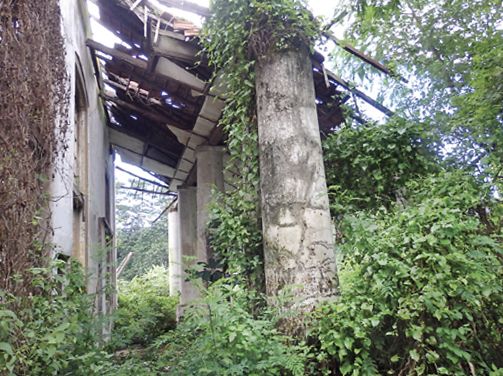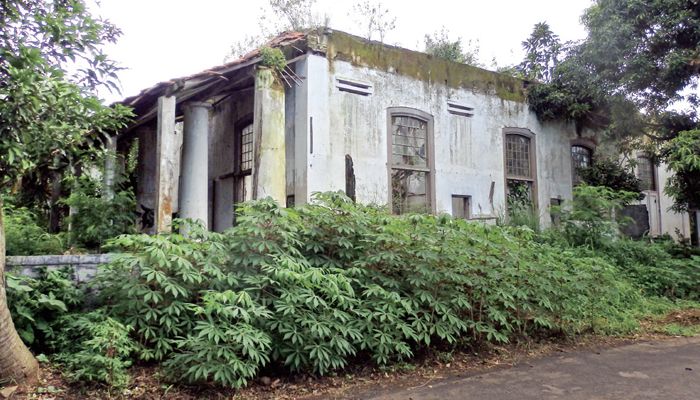IO – “It’s beautiful and its unique,” said Ratu Farah Diba who heads the Depok Heritage Community of the bucolic Cimanggis Manor House. Cimanggis Manor was built between 1771 and 1775 by David J. Smith and later bought by the widow of Governor General Van der Parra, Adrianna Johanna Bake who was the daughter of the governor of Ambon, David Johan Bake. She was known for having manumitted her slaves in her will and was known as the foster mother of a large number of East Indies orphans. The manor was built as a plantation house and with a large estate in the Depok area outside of Jakarta.

“It is of important architectural significance because its design combines Baroque and Neo-Classical elements which were then harmonized with Indonesian architectural traditions that seek to make a house cool and comfortable in the hot tropical weather. This manifests itself in the elegant verandahs that enclose the house, and the steeply sloping roofs built to deal with the heavy tropical down pours common in the rainy season. It’s an important part of Indonesian architectural history. I mean, how many 18th century buildings with European Baroque influences are there still remaining in Indonesia? You can count them on your fingers: Gedung Arsip on Jalan Gajah Mada, Toko Merah and Baron Von Wurmb’s House in Kota Tua and the Angke Mosque. Those are the only ones I can think of. There are still quite a few 19th or 20th century country estates – although these too are rapidlydisappearing – but not 18th century manors,” stressed Bambang Eryudhawan a member of the National Team of Heritage Experts who also heads the Jakarta Heritage Project Review Board.
The house is indeed a jewel with beautifully carved Baroque fan lights depicting baskets of flowers and what looks like the figure of a child with acanthus leaves, and stately white columns. French doors open out on to green gardens and 18th century sash windows still retain most of their original glass.
After independence the house became the property of Radio Republic Indonesia which had one of its broadcasting towers on the property and the house was used as accommodation for several RRI employees and their families. At a certain point the property exchanged hands and ownership passed to the Ministry of Religious Affairs. The families moved out and for a few years the house was open to the Depok community living around it. Bazars were held regularly in the building and in its grounds. The rubber trees remaining from the time it was a plantation house give the house an air of sitting in a park – which the community enjoyed.
Now however, the fate of Cimanggis Manor lies in the balance. The Ministry of Religious Affairs has determined that the large property will be used as part of the campus of the Indonesian Islamic International University that is now in the process of being established and the university apparently would like to tear down Cimanggis Manor.

In the meantime, the property has been closed off for community use and the government has allowed it to fall into a sad state of neglect. Most of its roof is now gone, some of the glass is missing. Lutfi Yondri, head of the West Java Regional Team of Heritage Experts says, “Restoring it would not be that difficult. There is still enough of the building left to do so. However, this needs to be done as soon as possible for once the roof of a building is gone decay especially for the wooden doors and windows, their frames and the beautifully carved fanlights can rapidly occur.”
The Vice-President Jusuf Kalla however has spoken out against preserving Cimanggis Manor, contemptuously remarking that it is just a Dutch colonial building built by a corrupt governor general and is therefore not worthy of being a heritage site.
Bambang Eryudhawan who heads the Jakarta Heritage Project Review Board of the Jakarta Municipality disagrees, “Well, if all colonial buildings no matter how attractive are not worth preserving perhaps we should start by tearing down the presidential palace, followed by the Vice President’s office.
I don’t recommend that we worship all things colonial as some people seem to do, to the point even of demanding that replicas of colonial buildings no longer existing be rebuilt. Some years ago for example there were some people who wanted to rebuild the old Holland Gate of Kota Tua (the Old Town area of Jakarta). I don’t agree with that- but we should preserve what still remains. Not because it’s a colonial building or because it was once the country estate of a governor general but because it’s part of Indonesia’s architectural history and it is part of the struggle against forgetting. Buildings like this are traces of the past that help the younger generation understand our history… our story. What story? Why the story of our victory, our victory over our colonial masters – how we forged our independence. We must not forget that this building now belongs to us. We built it and it remains as a sign of our great victory, our independence. This house is part of our story too.”
Komaruddin Hidayat, the head of the Development Committee of Universitas Islam Internasional Indonesia who is reported to stand a good chance of becoming rector of the university is reported by Lutfi Yondri, who heads the West Java Regional Team of Heritage Experts, to have said that for the present time the Cimanggis Manor house will not be torn down. This sounds ominous as it seems to suggest that Cimanggis Manor is only safe for a limited period and will one day be pulled down. The house has a guardian angel though in the form of a feisty lady named after the beautiful wife of the former Shah of Iran, Farah Diba. She is the head of the Depok Heritage Community and has spent time and energy relentlessly researching the manor, lobbying to protect it and carrying out a media campaign on behalf of the building and its supporters and admirers not only in Depok but around Indonesia.

Farah Diba who has a law degree from Universitas Pancesila established the Depok Heritage Community in 2011 which now has over 300 members. (Another heritage organization that is campaigning to have Cimanggis Manor protected is the Komunitas Sejarah Depok). Depok’s history may be traced back to the 17th century when Cornelis Chastelein established an estate there with many slaves. Later in his will he manumitted his slaves and left the estate to them. Until the Japanese Occupation they had their own form of government. Beside the Cimanggis Manor there is an old church, 19th century houses, the Panus bridge and other heritage buildings in Depok. “Cimanggis Manor is however, the only remaining historic building that is genuinely beautiful and with a park,” remarked Farah Diba.
The Indonesian International Islamic University was established by Presidential Decree no 57 of 2016 which provides that the university’s main purposes is to help develop and promote a tolerant, pluralistic and open Islam which supports national unity and democracy – the type of Islam practiced in most parts of Indonesia for centuries. Although when questioned whether the Islam promoted by the university would be what the Minister of Religion has referred to in the past as Islam Nusantara or Achipelagic Islam, Komaruddin Hiidayat refused to comment. “The university will be a post-graduate research university,” he said. Komaruddin Hidayat who currently, heads the Development Committee of the university and who many believe is also a strong candidate for the position of rector of the university states, “The university will advise the government on policies.” The Presidential Decree states that it will also help Indonesia’s Ministry of Foreign Affairs with its diplomacy especially with regard to promoting Indonesia’s moderate form of Islam. The university will stand on 143 hectares of land, of which only 15% will be built on.
Meanwhile, the Ministry of Education and Culture has instructed the BPCB or Heritage Protection Agency for West Java, Lampung, Banten and Jakarta to instruct the West Java Regional Team of Heritage Experts to investigate Cimanggis Manor in order to prepare a recommendation for the Mayor of Depok, Mohammad Idris to declare it a heritage building. Once they do this, under Indonesian Heritage Law number 11 of 2010 the Mayor must do so within 30 days.

“However even if this is not done Cimanggis Manor is already legally protected because under the Indonesian Heritage Law buildings and structures that are suspected of being heritage objects must be treated exactly the same as heritage objects until they are either declared heritage objects or not heritage objects. Once the Ministry of Education and Culture sent out its letter of instruction to the Heritage Protection Agency, Cimanggis Manor became an object suspected of being a heritage object,” explained Lutfi Yondri.
It remains to be seen how the university will deal with this issue but most people expect a state university funded by tax payers’ rupiahs to set an example in respecting the law. “Depok fulfills the UNESCO concept of a heritage city and it needs to be revitalized. Development of the university is one thing and heritage preservation is another and in the future a point must be reached that accommodates the two,” added Lutfi Yolandri.
Vice President Jusuf Kalla however, has said that there is no point in preserving the Cimanggis Manor which has such an unworthy past when faced with a new university that represents the future and is tasked with the spread of moderate Islam. It is however, exactly in the context of spreading a moderate and tolerant Islam that supports pluralism and diversity that Cimanggis Manor represents the university’s first test case and an opportunity to show prove that tolerance, openness and diversity.
Mention has been made of such figures as Abdurrachman Wahid (Indonesia’s fourth president and leader of NU (the largest Muslim organization in Indonesia who was affectionately known as Gus Dur) and Nurcholish Madjid, a well-loved Indonesian Islamic scholar who used to be called Cak Nur, as figures that inspired the creation of the university. Both of them had close friendships with all sorts of people from very varied beliefs and groups. It might help the university to decide how to treat Cimanggis Manor and the people who wish to see it preserved if it remembers that neither Gus Dur nor Cak Nur would have had the slightest problem with the Cimanggis Manor. They would have embraced the beautiful house and the Depok Heritage Community’s wishes to preserve it and found a wise and inclusive solution leaving the house and the community satisfied and intact and the university providing the nation with an example of what tolerance, diversity and inclusiveness is all about. (Tamalia Alisjahbana)

